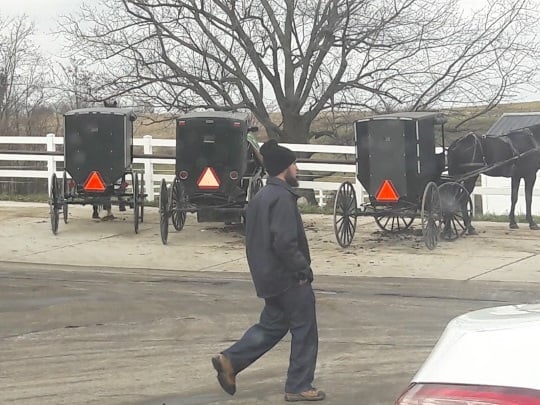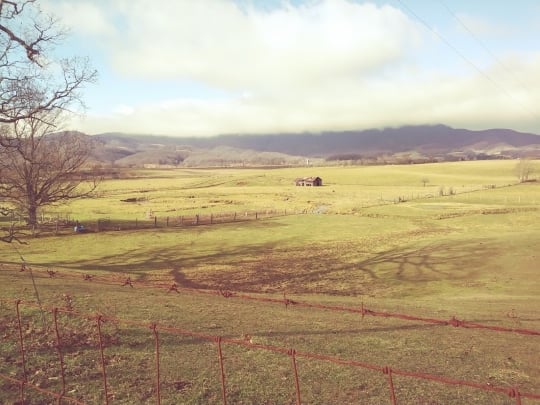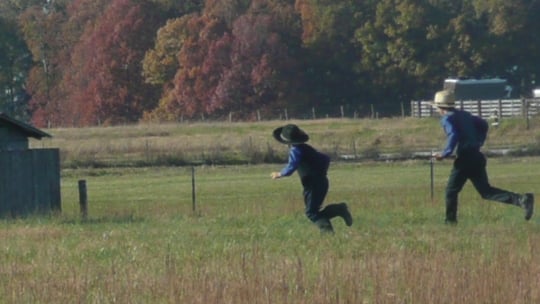New York still drawing Amish and Mennonites
Since 1974, David Luthy has periodically released a directory of Amish communities appearing in Family Life, with updates appearing every 5 to 10 years (the last was in 2008).
Writing in last July’s issue of Family Life, Luthy observes “with 62 counties in its 49,109 square miles, New York has in the past ten years become a popular state for Amish landseekers. Such, however, was not always the case and was slow to occur. In the 1974 directory there were only two settlements. As of May 2012 there are 47” (“Yesterdays and Years: Amish Migration Revisited: 2012”).
Luthy observes the especially rapid NY Amish growth over just the past few years: “from 2007 to May 2012 – a mere 4 1/2 years – major migration to and within New York occurred. Eighteen more settlements were founded, an unheard of number for such a short time.”
Going by anecdote, the state remains attractive in 2013. While in Pennsylvania, I heard of much migration from Old Order Mennonites to New York, as well as a new Nebraska Amish community in the Empire State.
Mohawk migrants
One of the relatively new NY communities can be found in the vicinity of Little Falls, in Herkimer County (part of the Mohawk Valley Amish conglomeration). The writer of this recent piece on Amish and Mennonite migration visits with Lydia Zook, whose family has a business selling sheds and assorted woodcraft. Her part of New York is colder, but emptier than back home.
“Back home” happens to be Lancaster County. Amish and Mennonite arrivals to the area have found their money goes a lot further in central NY than it does in southeastern PA: “For example: An 85-acre plot in Newport in Herkimer County listed by Weichert Realtors of New Hartford is selling for $65,000. Comparatively, a 51-acre parcel in Holtwood, Pa., recently sold for $500,000, said Matt Ziegler, sales manager for Weichert Realtors in Lancaster County.”
Holtwood is in southern Lancaster County and somewhat off the beaten path regarding the Amish community, which has its center 20-some miles away. Prices are likely even higher in heavier-demand areas of the county.
As we’ve addressed many times before, Amish migrants sometimes encounter problems meshing with local communities. A local official “says he’s seen challenges ranging from families dropping their children off at corners to sell products without a permit to Amish buggies being hazards on the roads.” However “citizens are getting used to knowing that there may be a horse and buggy.”
Heavy growers
Besides New York, other states making big jumps in the period Luthy studied include Illinois, Kentucky, Iowa and Minnesota. In 1974 Arthur was the sole Amish settlement in the Land of Lincoln. As of last May there were 17 other Amish communities in the state. Kentucky multiplied from 2 to 36 communities over that span, while Minnesota and Iowa went from 3 and 4 to 15 and 23, respectively.
Where will Amish settle most heavily in future? Luthy closes his latest update with a few ideas: “No one knows what is on the horizon, but the states to watch are Illinois, Kentucky, Iowa, Michigan, Minnesota, Missouri – and, of course, New York which is by far not filled up.”







I am glad they are coming to my State, New York. I was really surprised on how much cheaper land is here than in Pennsylvania.
Marilyn
Erik,
Where are the Nebraska Amish settling in New York? Thanks for the heads up.
Tom backroadstraveller.blogspot.com/
I’m not sure Tom. I may have been told but it exited the other ear.
I live in MN and I am very grateful to have Amish in our state. I know a new community started in East Central MN about 20 months ago and 2 more communities have started within the past few months. I love to meet them and help support them.
New York Amish
I read this post to Mark. He said that there was a family from Belle Center that moved to New York and was one of the founding families at the Canastota, NY settlement. Also, a number of families, mainly relatives, have joined them there coming from Holmes County. Mark explained that New York attracts the Amish because of the land prices and the availability to big city markets for their products. The land there, unlike in the midwest, is not suitable for the big grain farmers who are grabbing up every available acre in Ohio, Indiana, etc. The farms in Upstate New York tend to be smaller farms, around a hundred acres or so. The land is kind of hilly and broken up with valleys and such. Not good for grain farms but good for dairy herds. The English farmers are getting older and wanting to retire and none of their children want to take over the farms. But, the Amish are more than willing to step in and take over the farms and build them back up.
Canastota NY Amish
Interesting Don, here’s a little further info from David Luthy’s article: of the 18 new New York settlements founded from 2007-mid 2012, 10 of them originated from existing settlements in New York. 5 were from Pennsylvania, 2 each from Michigan and Wisconsin, and 1 from Ohio (Conneaut). Looks like that Canastota community was started a little before this period, in 2006. It sounds like there is room to grow.
Erik,
I never realized how often some Amish move. Some of the first Amish I met nearly 20 years ago were in Conewango, NY and they moved to Conneaut Ohio. The Conneaut settlement also spills over into PA. I will have to check and see if they have the moving bug. My take is that it is easy for some to “get a bug in their bonnet” and pull up stakes. Didn’t know about Canastota, I don’t get there often.
Tom
Farm outside Rome, NY
Can someone advise on how I can contact the Amish communities around central NY? I have around 200 acres of farm/pasture/woods that is available for purchase. The farm is located about 2 miles outside of Rome NY in Oneida County. This was a dairy farm that was in business until 1980. Since then the land and associated buildings have been rented out for crops, living, etc. The buildings include 2 houses (1 vacant and 1 rented), 1 large dairy barn and an adjacent milk plant that was used to process and bottle milk (now vacant). I can be reached at 919 602-0360. Thanks. Joe B
Welcome, Amish "neighbors"!
I was surprised to read about an increase of new Amish settlements in my state (IL). I wish there were a way to entice them to my county! I’ll further investigate the other Amish settlement areas when I have a little more time (lunch time now, at work).
Of course, any regular reader here knows the Amish are an ever-growing population! 🙂
Thanks, Erik!
Alice Mary
Some Amish leaving New York?
Here is a Facebook comment I just noticed on this article:
interesting… here in marathon, ny we have at least 1 amish family moving back to pa because our land taxes are so high. they bought the land at a good price but didn’t realize how high the taxes were… and they had anticipated that ny would be hyrofracking for gas by now (but there is still a moratorium). there are at least 4 other familes that want to move back to pa.
Interesting comment
People often don’t ask enough questions before making a move; if property taxes are low there is often a state income tax and/or high sales or franchise taxes. If property taxes are high, there may not be a state income tax and or sales / franchise taxes may be lower. People moving to Texas from the west coast or east coast are often thrilled when they learn there is no state income tax, but when they get their bill for property taxes they come back to earth a little bit. My dear old dad use to tell me: “Son, there ain’t no free ride”. Grammatical problems aside, he was correct … there really isn’t.
Real estate prices in the northeast corridor have amazed me for years; urban and sub-urban prices are often so high that I can’t figure out how people can even afford to live there. Rural prices can be surprisingly affordable though. Sometimes there almost seems to be a disconnect between the two. I haven’t ruled out moving there myself, but I doubt that I could get my bride to go with me. She is adverse to cold weather. Doesn’t rule out extended visits though, because I really love that part of our beautiful country.
Oldkat,
Sounds like “your dear old dad” was a smart man.
Tom
True
Yes,that is true. Actually he was pretty darned smart. Unfortunately, I didn’t recognize that fact at the time.
Turns out the saying about parents knowing nothing when you are 18, but the older you get the smarter they get … is also true!
Oldkat,
Amen, the same was true with my father and I. I miss him and his old school wisdom.
Tom backroadstraveller.blogspot.com/
Yes… i was the one that left the fb comment. Our very closest friends here in marathon ny have decided that ny taxes are too high and there just aren’t the job opportunities they had expected. They had tried dairy farming but found it didn’t provid enough income. They had expected the gas companies to come in and start drilling. But ny still has a drilling moratorium. So their land is for sale. They will be heading back to smicksburg, pa as soon as the land sells. And i know of at least 4 other families considering moving back…
I always enjoy reading the updates about the growth of Amish
settlements, especially in “pioneer” areas for the
Amish. I still think that 20 years from now, about the only
traditional small family farms left may be those owned by
Amish families.
Al,
I have seen in New York State that when an “English farmer” retires and has no one in the family to pass the farm to, that others big “English” farmers or sometime Mennonite farmers will snap up the best land and if there are Amish around they will buy the rest on the cheap. Many of my Amish friends are “penny wish and dollar foolish”. Price sometimes drives the bargain.
Tom